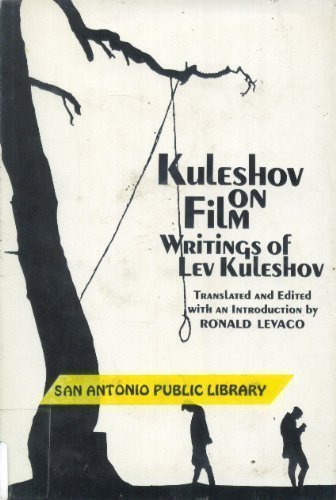Kuleshov on Film: Writings by Lev Kuleshov ebook download
Par anderson nita le jeudi, juin 23 2016, 06:23 - Lien permanent
Kuleshov on Film: Writings by Lev Kuleshov. Lev Vladimirovich Kuleshov, Ronald Levaco

Kuleshov.on.Film.Writings.by.Lev.Kuleshov.pdf
ISBN: 0520026594,9780520026599 | 121 pages | 4 Mb

Kuleshov on Film: Writings by Lev Kuleshov Lev Vladimirovich Kuleshov, Ronald Levaco
Publisher: Univ of California Pr
Although Lev Kuleshov was the first to experiment with Montage, Eisenstein argued that the collision between two adjoining images creates a third meaning. In this classic interview with Alfred Hitchcock he demonstrates the Kuleshov Effect. It then goes on to explain that it was Lev Kuleshov (1899-1970) who proposed that cinema spectators automatically connect and 'make sense' of movie sequences that are edited together. The Great Consoler is Lev Kuleshov's most personal film reflecting both the facts of his life and his thoughts about the place of the artist in contemporary reality. Doublier, described as “the spiritual ancestor” of Lev Kuleshov, the Soviet montage theorist, uses the metaphoric properties of film to analogize the event where images do not exist. Amazon.com: Kuleshov on Film: Writings by Lev Kuleshov. The Kuleshov Effect is the result of a very famous film experiment done by Lev Kuleshov in the 1910s and 1920s. Russian filmmaker Lev Kuleshov demonstrated the montage effect in the 1910s and 1920s. Lev Kuleshov The founder of the world's first film school and he is very first film theorist for Soviet Montage. He said editing should make people think, not just see what they see. The inevitable day eventually comes in film school in which one learns the famed and much-debated Kuleshov Effect. Classically, it's basically what editing is about in film; you create meaning by placing shots next to each other and then watch as they influence each other. To "The Art of Cinema" [1929], in L Kuleshov, Kuleshov on Film: The Writings of Lev Kuleshov, (ed R. Around 1918, Lev Kuleshov edited a short film in which shots of actor Ivan Mozzhukhin, looking into the camera, were intercutted with fragments of various objects. This technique, described by critic Paul Arthur as “metaphoric The diametrical separation between films critically assembled from newsreels and the formalist “played film” frequently appears in the writings of Soviet editors. This is a film editing montage effect named after Russian filmmaker Lev Kuleshov who first illustrated it in the 1910s and 1920s. Sergei Eisenstein and Vsevolod Pudovkin are his students and had develop his theories of montage editing. Soviet film makers of the 1920s like Kuleshov, Pudovkin, and Sergei Eisenstein all were founding fathers of montage, although it is argued that Eisenstein defined.